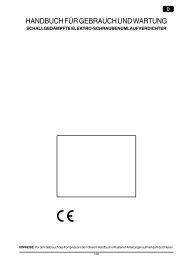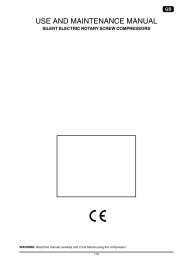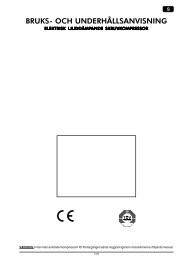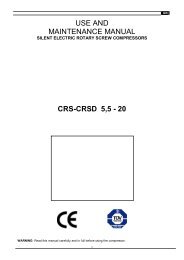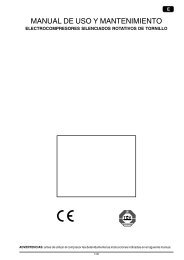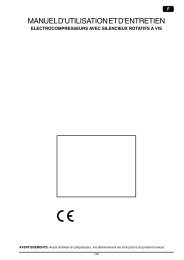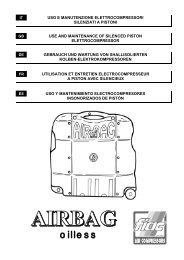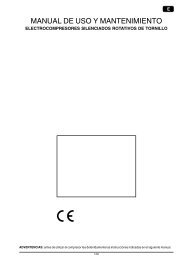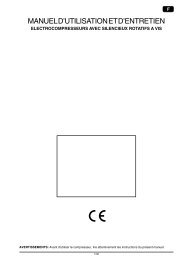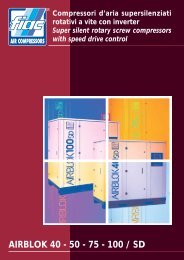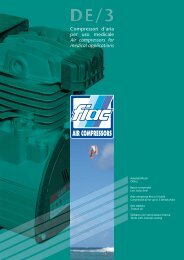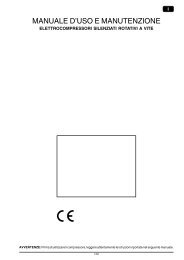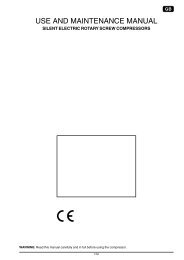GM - TR - VX - AB - CCS
GM - TR - VX - AB - CCS
GM - TR - VX - AB - CCS
You also want an ePaper? Increase the reach of your titles
YUMPU automatically turns print PDFs into web optimized ePapers that Google loves.
GBIMPORTANT INFORMATIONRead and understand all of the operating instructions, safety precautionsand warnings in the Instruction Manual before operating or maintainingthis compressor.Most accidents that result from compressor operation and maintenanceare caused by the failure to observe basic safety rules or precautions.An accident can often be avoided by recognizing a potentially hazardoussituation before it occurs, and by observing appropriate safetyprocedures.Basic safety precautions are outlined in the “SAFETY” section of thisInstruction Manual nad in the sections which contain the operation andmaintenance instructions.Hazards that must be avoided to prevent bodily injury or machine damageare identified by WARNINGS on the compressor and in this InstructionManual.Never use this compressor in a manner that has not been specificallyrecommended by manufacturer, unless you first confirm that the planneduse will be safe for you and others.MEANINGS OF SIGNAL WORDSWARNING: indicates a potentially hazardous situations which, if ignored,could result in serious personal injury.CAUTION: indicates a hazardous situations which, if ignored, couls resultmoderate personal injury, or could cause machine damage.NOTE: emphasizes essential informationSAFETYIMPORTANT SAFETY INS<strong>TR</strong>UCTIONS FOR USEOF THE COMPRESSOR.WARNING:DEATH OR SERIOUS BODILY INJURY COULD RESULT FROMIMPROPER OR UNSAFE USE OF COMPRESSOR. TO AVOIDTHESE RISKS, FOLLOW THESE BASIC SAFETY INS<strong>TR</strong>UCTIONS.READ ALL INS<strong>TR</strong>UCTIONS1. NEVER TOUCH MOVING PARTSNever place your hands, fingers or other body parts near thecompressor’s moving parts.2. NEVER OPERATE WITHOUT ALL GUARDS IN PLACENever operate this compressor without all guards or safety featuresin place and in proper working order. If maintenance or servicingrequires the removal of a guard or safety features, be sure to replacethe guards or safety feature before resuming operation of thecompressor.3. ALWAYS WEAR EYE PROTECTIONAlways wear safety goggles or equivalent eye protection.Compressed air must never be aimed at anyone or any part of thebody.4. PROTECT YOURSELF AGAINST ELEC<strong>TR</strong>IC SHOCKPrevent body contact with grounded surfaces such as pipes,radiators, ranges and refrigeration enclosures. Never operate thecompressor in damp or wet locations.5. DISCONNECT THE COMPRESSORAlways disconnect the compressor from the power source andremove the compressed air from the air tank before servicing,inspecting, maintaining, cleaning, replacing or checking any parts.6. AVOID UNINTENTIONAL STARTINGDo not carry the compressor while it is connected to its power sourceor when the air tank is filled with compressed air. Be sure the knobof the pressure switch in the “OFF” position before connecting the18compressor to its power source.7. STORE COMPRESSOR PROPERLYWhen not in use, the compressor should be stored in dry place.Keep out of reach of children. Lock-out the storage area.8. KEEP WORK AREA CLEANCluttered areas invite injurues. Clear all work areas of unnecessarytools, debris, furniture etc…9. KEEP CHILDREN AWAYDo not let visitors contact compressor extension cord. Alla visitorsshould be kept safely away from work area.10. DRESS PROPERLYDo not wear loose clothing or jewerly. They can be caught in movingparts. Wear protective hair covering to contain long hair.11. DON’T <strong>AB</strong>USE CORDNever yank it to disconnect from receptable. Keep cord from heat,oil and sharp edges.12. MAINTAIN COMPRESSOR WITH CAREFollow instructions for lubricating. Inspect cords periodically and ifdamaged, have repaired by authorized service facility.Inspect extension cords periodically and replace if damaged.13. OUTDOOR USE EXTENSION CORDSWhen compressor in used outdoors, use only extension cordsintended for use outdoors and so marked.14. STAY ALERTWatch what you are doing. Use common sense. Do not operatecompressor when you are tired.Compressor should never be used by you if you are under the influenceof alcohol, drugs or medication that makes you drowsy.15. CHECK DAMAGED PARTS AND AIR LEAKBefore further use of the compressor, a guard or other part isdamaged should be carefully checked to determine that it will operateproperly and perform its intended function.Check for alignment of moving parts, binding of moving parts,breakage of parts, mounting, air leak, and any other conditions thatmay affect its operation.A guard or other part that is damaged should be properly repairedor replaced by an authorized service center unless otherwiseindicated elsewhere in this Instruction Manual. Have defectivepressure switches replaced by authorized service center.Do not use compressor if switch does not turn it on and off.16. HANDLE COMPRESSOR CORRECTLYOperate the compressor according to the instructions providedherein. Never allow the compressor to be operated by children,individuals unfamiliar with its operation or unauthorized personnel.17. KEEP ALL SCREWS, BOLTS AND COVERS TIGHTLY IN PLACEKeep all screws, bolts, and plates tightly mounted.Check their condtions periodically.18. KEEP MOTOR AIR VENT CLEANThe motor air vent must be kept clean so that air can freely flow atall times. Check for dust build-up frequently.19. OPERATE COMPRESSOR AT THE RATED VOLTAGEOperate the compressor at voltages specified on their nameplates.If using the compressor at a higher voltage than the rated voltage, itwill result in abnormally fast motor revolution and mey damage theunit and burn out the motor.20. NEVER USE A COMPRESSOR WHICH IS DEFECTIVE OROPERATING <strong>AB</strong>NORMALLYIf the compressor appears to be operating unusually, making strangenoises, or otherwise appears defective, stop using it immediatelyand arrange for repairs by a authorized service center.21. DO NOT WIPE PLASTIC PARTS WITH SOLVENTSolvents such as gasoline, thinner, benzine, carbon tetrachloride,and alcohol may damage and crack plastic parts. Do not wipe themwith such solvents. Wipe plastic parts with a soft cloth lightly



